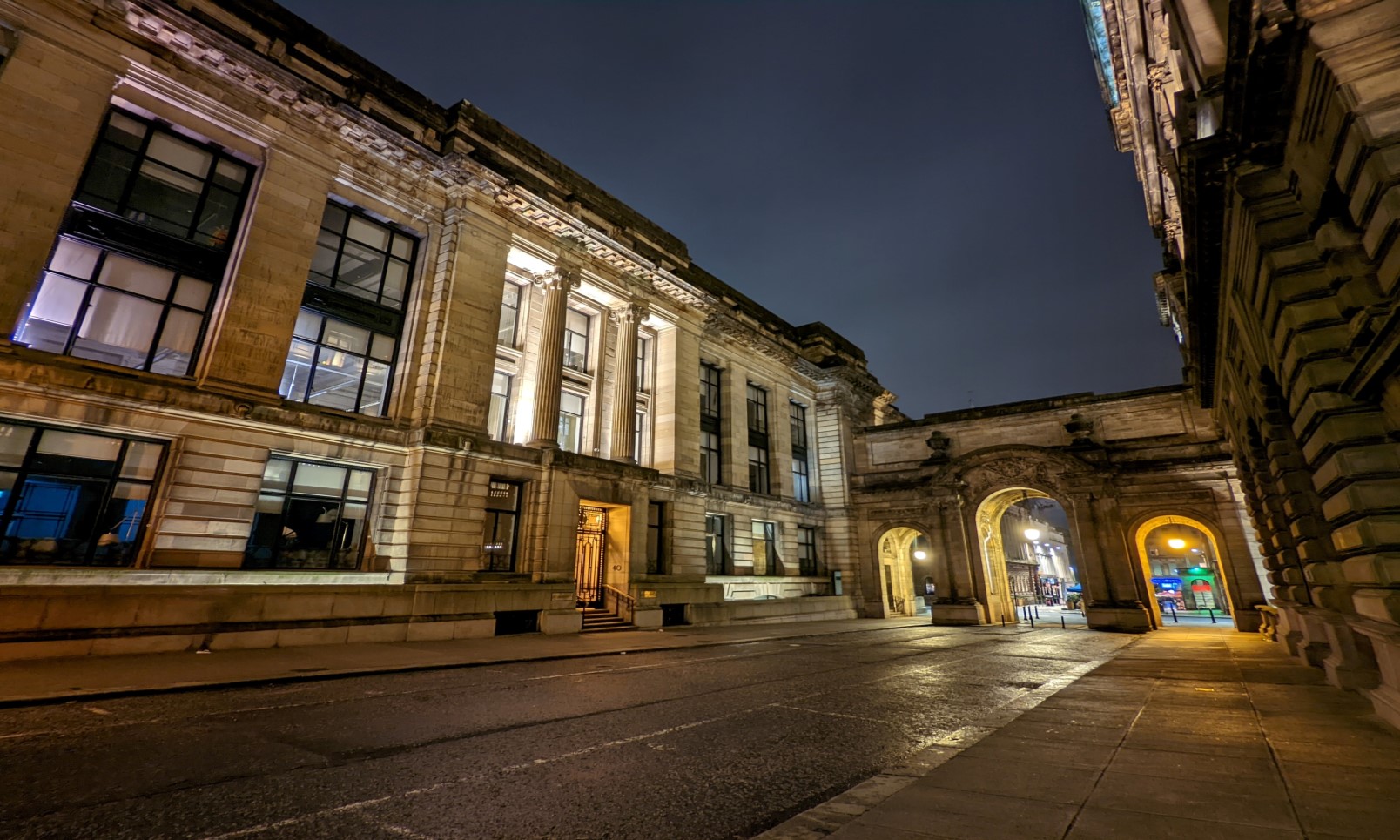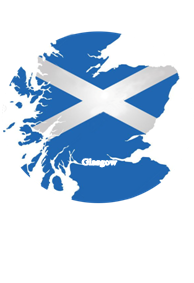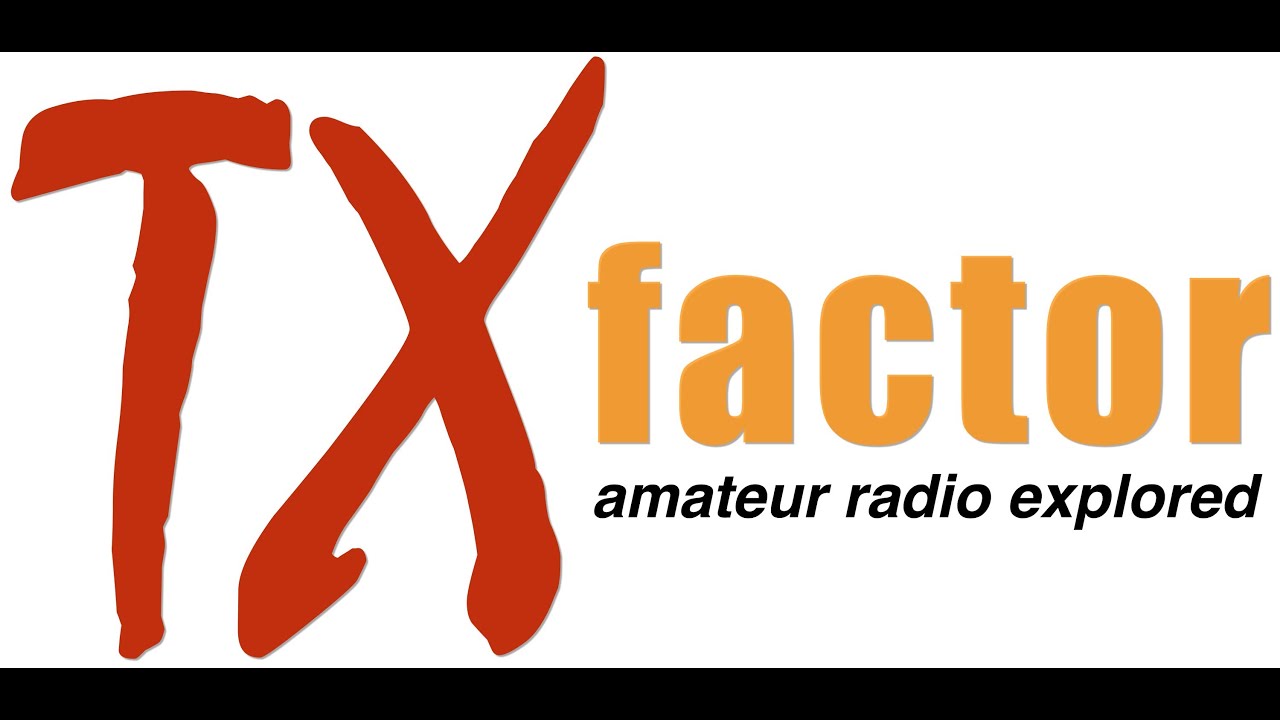WOTRA 2020 (Women On The Radio Award) Report

WOTRA 2020 (Women On The Radio Award) – Ángeles M.T (EC1YL)
A large number of radio amateurs from around the world, participated in the 2020 annual event.. More Awards for YL’s stations were delivered this year, thereby fulfilling the group mission of encouraging more YL participation.
In 2019 when the Award was launched, the event was more of a practice session, but one year on (2020) it can be considered a success thanks to the increased interest and participation of YLs.
This year, WOTRA has focused more on the work of the Special-Event-Stations and their regular attendance on the bands, rather than on the individual making a certain number of QSO’s.
Becoming involved required commitment and the responsibility of regular participation.
Much effort and determination was needed in an event at this level. Not always an easy task and for this reason, several of the participants who started at the beginning of November, found themselves unable to continue through to the end.
Special thanks to the Operators that participated throughout, they displayed great team-work and coordination amongst everyone. In alphabetical order they are:
Ana – EI / EA7KMA
Angels – EC1YL
Carmen – DM4EAX
Cath – MW7CVT
Laila – OE3LZA
Pink- LU7IRS
Ydorca (Mariela) – YV5EVA
Zulema – CO8MGY
In particular I would like to recognise Zulema Gonzalez Ochoa CO8MGY from Cuba. To reward and recognize her work, as the operator that made the most QSO’s, especially as it was her first year in this great event, She participated with enthusiasm and dedication.
Laila OE3LZA, also had the privilege of being able to get her beautiful Award for her contact with my special station on November 25 (EH1YL), on the occasion of the ‘International Day against Gender Violence’.
Special thanks of course to all the Operators of the Wotra Award 2020 and for their effort to contact their WOTRA colleagues and in obtaining their beautiful Awards. (2 Dec, 2020)
Women on The Radio is a Radio Group, created by Ángeles M.T ( EC1YL), for licensed Radio Amateur YL’s Worldwide https://web.facebook.com/groups/1913222872262810/about
[EDIT – COX: And from a UK perspective BYLARA (British Young Ladies Amateur Radio Association – also available via QUICKLINK)]
Snips – News For Scotland – 27th December
The news headlines:
- Thanks and seasonal greetings
- Charity auction raises over £1000
- New GB2RS News Manager appointed
GB2RS (inc 3rd Jan) Script – HERE .
CLUB NEWS
GMDX Group – Member Neil G0JHC reports that fellow member Ian Brown GM4YSN has become SK following a long illness. Ian was a member and regular at the convention over the years, always a big signal from his impressive station in the Borders. (Gavin GM0GAV)
And also: the GMDX announces the January Activity Challenge 2021.The Challenge shall start at 0001z on 1st January 2021 and end at 2359 on 31st January 2021. The Challenge is open to all current members of GMDX. The challenge is to work as many different DXCCs during the time period. For further details checkout the GMDX Website.
Also Checkout the WoSARS RADIO NETS Page for ‘On-Air’ Nets taking place.
Calling Mrs Boye On Vanikoro
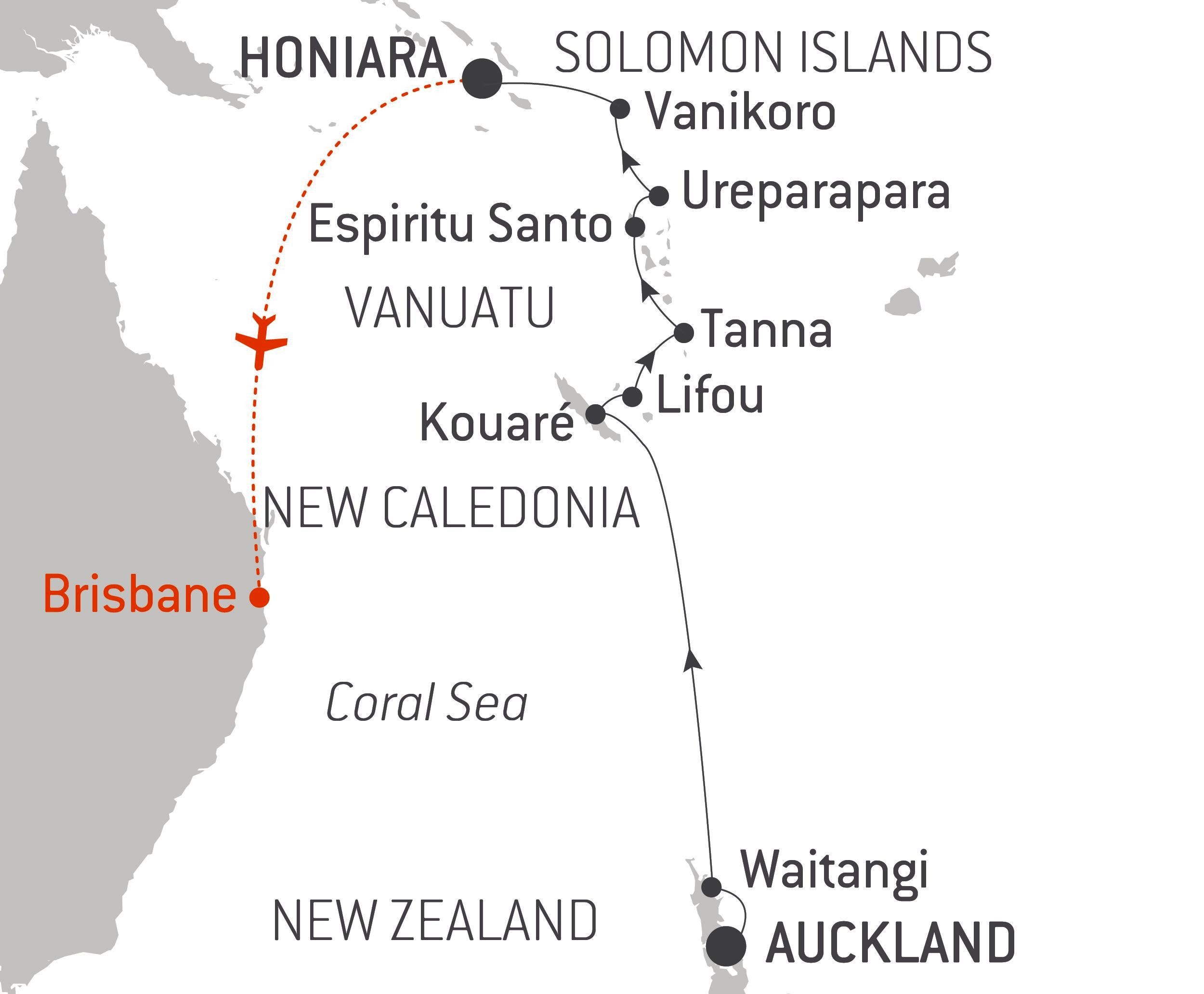
By: Petar Djokovic (Royal Australian Navy – RAN)
“Calling Mrs Boye on Vanikoro.” So began a message from Japanese forces to Ruby Boye in 1942. What followed was a terse and direct threat for Ruby to discontinue her operations. Over the course of World War II, Ruby Boye operated the radio at VANIKORO in the Solomon Islands as Australia’s only female coastwatcher. Her service warranted a personal visit to Vanikoro by Fleet Admiral William F. “Bull” Halsey Jr, USN, and earned her a British Empire Medal (BEM).
Ruby was born Ruby Olive Jones on 29 July 1891 in Sydney, the fifth of eight children. She was working as a saleswoman when she married a laundry proprietor, Sydney Skov Boye who had previously lived in Tulagi in the Solomon Islands, in Sydney on 25 October 1919.
Skov returned to Tulagi, with Ruby and their son, Ken, in 1928 to take up his old position with Lever Brothers. Their second son, Don, was born shortly afterwards and the two boys would spend most of their school years in Sydney. In 1936 Skov accepted the position of Island Manager for the Kauri Timber Company’s logging operations on Vanikoro in the Santa Cruz group. Vanikoro is a mountainous island surrounded by a treacherous coral reef. There were no roads. The timber logged in the mountains was hauled to the harbour by rail tractors where they were rafted together to await shipping to Australia. Ships would arrive from Melbourne four times a year to collect the logs and at the same time delivered mail and supplies for the loggers. Around 20 Kauri employees, including a radio operator and a doctor, came to Vanikoro from Australia and New Zealand on two year contracts in addition to about 80 islander labourers.
The family lived in the island’s main village, Paeu, on the south-west coast of the island on the southern bank of the Lawrence River where crocodiles were common. A suspension bridge over the river led to the main part of the village as well as the company store, office, machine shop and living quarters for the company’s workforce.

An Island Paradise?
Upon the declaration of World War II, Lieutenant Commander (later Commander, OBE) Eric Feldt assumed responsibility for the naval coast-watching network in the South Pacific. Vanikoro formed part of the network; however, the operator wanted to return to Australia to join the RAAF. He suggested that Ruby could take over the operation of the radio until a replacement arrived. Ruby agreed and so learned how to operate the radio and compile weather reports using a panel of instruments and her own observations. She sent weather reports by voice four times a day, providing vital meteorological information for both ships and aircraft. No replacement was ever sent; there was no need as long as Ruby kept sending her reports. Ken and Don, meanwhile, returned to Australia to stay with relatives.
Timber production at Vanikoro ceased when the Japanese entered the war, and staff and their families left by ship. Skov decided to stay to look after the company’s interests while Ruby considered it her duty to continue operating the radio. With the departure of the doctor, Ruby also took on the responsibility of the health and welfare of the local islanders, many of whom travelled between the islands by canoe and brought Ruby information about Japanese movements and dispositions.
It was a courageous decision. Ruby was 50 and Skov was older, and they were the only non-Solomon Islanders left on the island. If the Japanese did invade the island, and Vanikoro was in a precarious position, they were defenceless. They received supplies infrequently and were often short of rations. No mail, newspapers or magazines were delivered, and the radio was strictly for intelligence use only. Ruby only ever received three personal messages over the radio; to advise her of the deaths of her father, mother and a sister.
Ruby initially directed her reports to Tulagi but when it fell to the Japanese in May 1942 she was directed to send her reports to Vila in the New Hebrides (Vanuatu). It was at this time in early 1942 that Ruby received the first of several threatening messages. One of her fellow coast-watchers, listening on the same frequency, responded to the Japanese operator “in language which they wouldn’t repeat to a lady.” For her part, Ruby remained unperturbed; “I felt just a little bit queer when I heard that voice but somehow I felt he was bragging… The mere fact that I was annoying them sufficiently to have them warn me off was somewhat gratifying.” Shortly afterwards Ruby’s radio was changed to a different frequency and she was instructed to transmit only in Morse Code, which she had taught herself.
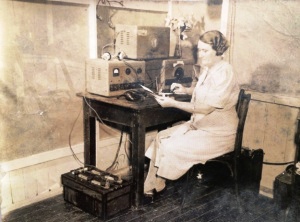
Ruby ‘Operating’ Her Vanakoro Station
Japanese reconnaissance planes were often heard overhead and on one occasion during the night, lights were seen and boat engines were heard around the reef lasting for around four hours. Ruby believed that the Japanese were trying to find the entrance to the harbour but abandoned their attempt to land when they were unable to do so. For safety reasons it was decided to move the radio equipment across the river away from the Boye’s home. After the suspension bridge across the Lawrence River collapsed, Ruby had to make the journey to the radio shack across the crocodile-infested river by punt and through ankle-deep mud four times a day.
In 1944 a Catalina flying boat refuelling station was established on the island. This meant an improvement in conditions for Ruby as supplies were delivered on a more regular basis; however, the station was also a target for Japanese air raids which occasionally damaged aircraft and tenders in the harbour.
Such was the appreciation for Ruby’s efforts that Admiral Halsey personally called on her at Vanikoro. He arrived in a flying boat and a small group of officers came ashore to be met by Skov. Halsey introduced himself; “Name’s Halsey. Not stopping for long, just thought I’d like to call in and meet that marvellous woman who runs the radio.” Halsey told Ruby that he was “playing hookey” by visiting.
It was around this time, in 1944, that Ruby developed shingles and Halsey arranged for a USN Catalina to fly her to Sydney for treatment. Four US servicemen were assigned to take over the operation of the radio during her convalescence; four men assigned to do the work that Ruby had been doing on her own. After three weeks in Australia, she re-joined Skov at Vanikoro and resumed her coast-watching duties.
As the Japanese were slowly pushed northwards, the Americans withdrew from Vanikoro in 1945 but Ruby diligently continued her work until until the news was received, via her tele-radio, that the war was over. The Kauri Timber Company resumed logging operations after the war and Ruby was officially employed as secretary to the manager while continuing to send weather reports to the Bureau of Meteorology. Ruby was presented with her BEM in 1946 in a ceremony in Suva.
In 1947 Skov fell ill and both he and Ruby returned to Sydney in August for diagnosis and treatment. Two weeks after being diagnosed with Leukemia, Skov passed away. Ruby briefly returned to Vanikoro to finalise affairs there before returning to Australia for good.
Ruby married Frank Jones in 1950 and took on the name Boye-Jones; but 11 years later, Frank too passed away. Ruby lived alone at her Penshurst home for the next thirty years before moving into a nursing home at the age of 96. She remained active and enjoyed the company of a vast network of friends and family. In her own words; “Age is a matter of mind and if you don’t mind, it doesn’t matter.” The then Chief of Naval Staff, Vice Admiral Mike Hudson, wrote to her on her 98th birthday saying; “Your name is synonymous with the finest traditions of service to the Navy and the nation. We have not, nor will not, forget your wonderful contribution.”Ruby passed away on 14 September 1990, aged 99. An accommodation block at the Australian Defence Force Academy, Canberra, is named in her honour, and the Ex-WRANS Association has dedicated a page to her in the Garden Island Chapel Remembrance Book.
Author: Petar Djokovic RAN Semaphore series.
https://www.navy.gov.au/…/
Snips – News For Scotland – 6th December
The news headlines:
- Get on the Air to Care wins award
- New IARU VHF handbook
- RSGB mounts Christmas charity auction
GB2RS Script – HERE .
Tony MM0TMZ – Regional Manager for RSGB Region1 – Scotland South & Western Isles
A reminder to all radio amateurs that certain frequencies are reserved in the Band Plans for use by the GB2RS broadcast service on Sundays. These include:
70.425 (4M) 145.525 (2M) 433.525MHz (70cms)
The schedules are published at:
https://rsgb.services/public/gb2rs/gb2rs_broadcast_schedule.pdf checkout WoSARS.com/QUICKLINK – GB2RS
All radio amateurs are asked to avoid these frequencies at the stated times.
The service areas of the different regions do overlap and the RSGB requests that the GB2RS frequencies are kept kept clear of all traffic during the broadcast period. Unlike normal amateur radio, the GB2RS bulletins are licensed as broadcasts and have to use fixed frequencies.
CLUB NEWS & NETS
Details of all known nets in Scotland are collated by RSGB Regional Rep Tony, MM0TMZ in association with Jack GM4COX and the West of Scotland Amateur Radio Society. These details are then published at https://wosars.club/radio-nets – RADIO NETS .
In the absence of club meetings, the West of Scotland Amateur Radio Society (WoSARS), has a daily FM net from 11am on 145.425MHz. Wednesday sees an FM net from 8pm on 433.425MHz and on Friday there’s an open net on 145.425MHz, also from 8pm. More details are at https://wosars.club
The Viking Amateur Radio Net runs on Sunday evenings from 6pm on 3.660 or 3.639MHz. Details can be found on their Facebook page.
Ayr Amateur Radio Group has a CW net on Sundays on 144.295MHz from 7pm and on 145.450MHz FM from 7.30pm. There are daily nets around 7.035MHz from 10.15am, moving to 7.065MHz and 145.450MHz at 10.30am. Friday sees a Zoom meeting, which may include a presentation. For details, email derek.secaarg@gmail.com.
Kilmarnock & Loudoun Amateur Radio Club has a net on Sundays from 2pm around 3.720MHz SSB, later moving to around 3.540MHz for a CW net. Tuesday sees a net on 145.475MHz FM from 7.30pm. For details, email klarcinfo@gmail.com.
Mid Lanarkshire Amateur Radio Society has a net on Sundays from 9pm on 28.475MHz. Wednesday sees the DMR Scotland net on TG23550 from 8pm and on Friday there’s a private club Zello chat from 7pm, which later moves to 2m. Details are at https://mlars.co.uk.
Wigtownshire Amateur Radio Society has a net on Sundays from 7.30pm on GB3DG, which usually moves to Zoom at around 8pm. Thursday sees a net on GB3DG from 7pm. There is also an open RAYNET net daily on GB3DG from noon. See www.gm4riv.org for further details.
Dundee Amateur Radio Club has nets on Sundays and Wednesdays from 7.30pm on GB3AG and on GB3DD. There is a Skype meeting on Tuesday Contact Martin, 2M0KAU on 07763 708 933 for further information.
Stirling and District Amateur Radio Society has a net from noon on Sundays on GB3FE. Monday and Thursday also see nets on GB3FE and on 145.550MHz from 7pm. Email secretary@gm6nx.com for details.
The Loch Lomond Sunday net takes place on 144.9625MHz in the Vale of Leven and surrounding areas and also via Echolink on gateway MB7 IBH-L from 8pm, moving to DMR TG 23559 from 9pm. Contact Paul, MM3DDQ via email to mm3ddq@yahoo.co.uk for further details.
Edinburgh & District Amateur Radio Club has its net on Monday from 8pm on 433.525MHz FM. Contact Norman, GM1CNH, on 07740 946 192 for further information.
Glenrothes & District Radio Club has open nets from 10am on 3.790MHz every day except Sunday. There are also FM nets on Tuesday and Thursday from 7.30pm on 145.425MHz and morse training is available. Further details from Tam on 07753 526 498.
Paisley Amateur Radio Club has an FM net on Mondays from 8pm on 144.550MHz and on Zello. Tuesday sees a DMR net in room 4415 from 8pm. On Thursday there’s a net on 144.550MHz FM and on Zello from 7.30pm.
Livingston & District Amateur Radio Society has a net on Tuesdays from 7.30pm on 145.575MHz FM. Wednesday sees a net on DMR Scotland TG23550 from 8pm. Contact Cathie, 2M0DIB on 01506 433 846 for further information.
On Wednesday Lothians Radio Society has a net on 144.350MHz SSB from 8pm. Email secretary@lothiansradiosociety.com for further details.
Caithness Amateur Radio Society holds nets on Wednesdays and Saturdays from 2pm on 3.740MHz LSB, ±QRM. Details are at www.QSL.net/ms0fnr.
Lomond Radio Club has a net on Thursdays from 7.30pm using 144.9625MHz to the MB7IBH Gateway and is also connected on EchoLink. Contact gm0kzx@googlemail.com for further information.
On Friday Strathclyde Park Amateur Radio Club has a net from 7.30pm on 145.400MHz, and also on the British Amateur Television channel from 8pm. Email Bill, MM0SFB at gm0syv@btinternet.com for further information.
Remember, if you wish to have your net listed on the WoSARS website or to report any changes to existing Scottish nets please contact Tony Miles MM0TMZ by email to rr1@rsgb.org.uk. Remember also to keep GB2RS updated via email to radcom@rsgb.org.uk the deadline for submissions is 10am on Thursday.
Funding Award Keeps Fife Museum Communicating
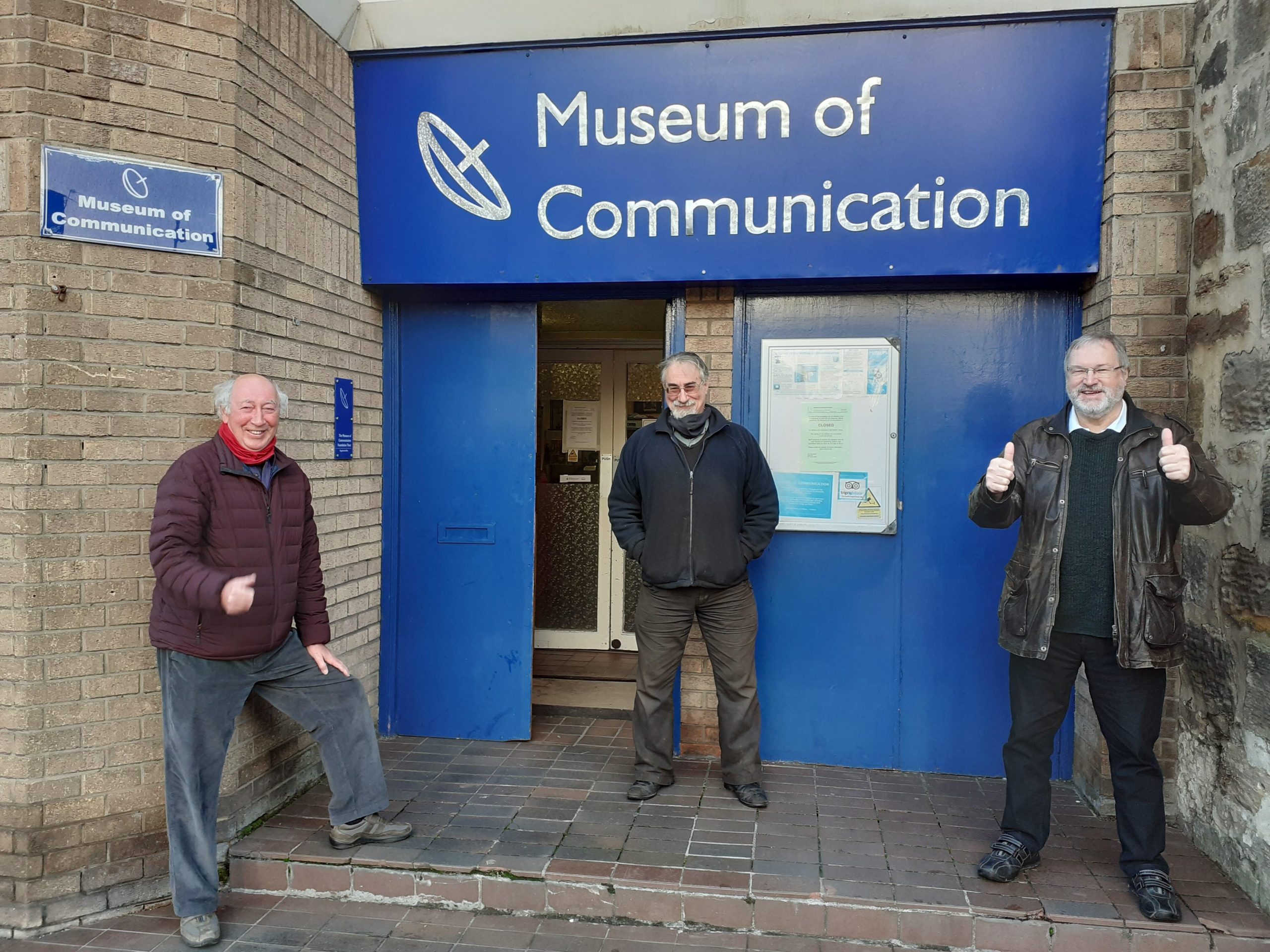
The Museum of Communication in Burntisland is pleased to announce an award in excess of £5,000 from the Recovery and Resilience Fund of Museums Galleries Scotland (MGS).
Museum of Communication Chairman Prof. Tom Stevenson said, “2020 has been a very lean year for us. The MGS award will help our entirely volunteer-run museum to survive through the winter as well as enabling us to upgrade our digital presence and prepare for reopening in2021. We’re eagerly looking forward to the day when we can once again offer everyone a fascinating visitor experience here in Burntisland.”
MGS has established the Recovery and Resilience Fund to secure the future of Scottish independent museums put at risk by the pandemic, thus safeguarding the vital role they play in their communities. MGS benefitted from a £4 million allocation from a £97 million package of Scottish Government funding to protect Scotland’s culture and heritage sectors from the impacts of Covid-19.
Lucy Casot, CEO of Museums Galleries Scotland said: “We are delighted to support the Museum of Communication through the Recovery and Resilience Fund. They have responded to the challenges of the pandemic, and subsequent temporary closure, with plans for increased online activities, which will continue to welcome their community and visitors from around the world to explore this fascinating museum.
The Museum of Communication’s responsive forward thinking is a credit to the volunteers who run the museum. We wish them every success as they work to deliver lectures to supporters across the world and safely reopen the museum in 2021 for their community.”
By David Brown – (e-mail dwbrown384@sky.com tel. 07886 915721)
- The Museum of Communication is a registered museum based at 131 High Street, Burntisland KY3 9AA. It is run entirely by volunteers.
- It was established in Bo’ness in 1992 and later moved to Burntisland, opening in 2005.
- It has an outstanding collection of communications-related material and offers lectures and other activities, currently online.
- For further information about the Museum of Communication see www.mocft.co.uk .
TX Factor – Episode 27 Available Soon
Extract off GB2RS (29th November)
Episode 27 TX Factor will soon be available.
In this latest episode the RSGB’s General Manager Steve Thomas, M1ACB explains how the Society’s positive response to the spring and summer lockdown helped to boost awareness of amateur radio in the UK.Steve stresses the importance of the ongoing work needed to maintain the impetus.
Bob, G0FGX and Mike, G1IAR get to grips with using an RF Shark openSPOT Hostspot for some mobile DMR action.
Bob visits Don Field, G3XTT at his new QTH near Wells to see how the editor of Practical Wireless created some simple antennas to swiftly resume his on-air activities. TX Factor episode 27 is proudly sponsored by the Radio Society of Great Britain and can be viewed at www.txfactor.co.uk.
Snips – News For Scotland – 22nd November
The news headlines:
- Spectrum Forum meeting details published
- Help wanted for eclipse propagation tests
- GB1NHS on the air over Christmas
GB2RS Script – HERE .
NEWS
Details of all known nets in Scotland are collated by RSGB Region 1 Regional Representative Tony, MM0TMZ in association with Jack GM4COX, and the West of Scotland ARS—they are published at wosars.club/radio-nets.
The GB2RS service is looking for newsreaders in the Scottish Borders and the Aberdeen area. There are also vacancies for standby readers in and around Elgin and Caithness. If you would like to volunteer then please contact Regional Representative Tony Miles by email on rr1@rsgb.org.uk. Newsreaders must be members of the RSGB.
Newsreader Rolfe, in Aylth, Scotland, who was the standby reader for the Perth area has recently become the primary reader. He has obtained good reports from the Dundee area for his 9am broadcasts, so filling the gap for a reader there. Gordon, 2M0PIJ from Clydebank has also been getting good reports for his newly introduced GB2RS broadcasts at 10am on DMR talk group 23559 in the west of Scotland.
CLUB NEWS (and Nets)
In the absence of club meetings, West of Scotland ARS has a daily net from 11am on 145.425MHz. Wednesday sees a net from 8pm on 433.425MHz, and on Friday, there’s an open net on 145.425MHz, also from 8pm. More details at wosars.club.
The Viking Amateur Radio Net runs on Sundays from 6pm on 3660 or 3639kHz. Details are on their Facebook page.
Ayr Amateur Radio Group has a CW net on Sundays on 144.295MHz from 7pm, and on 145.450MHz FM from 7.30pm. There are daily nets around 7.035MHz from 10.15am, moving to 7.065MHz and 145.450MHz at 10.30am. Friday sees a Zoom meeting, which may include a presentation. For details, email derek.secaarg@gmail.com.
Kilmarnock and Loudoun Amateur Radio Club has a net on Sundays from 2pm around 3.720MHz SSB, later moving to around 3.540MHz for a CW net. Tuesday sees a net on 145.475MHz FM from 7.30pm. For details, email klarcinfo@gmail.com.
Mid-Lanarkshire Amateur Radio Society has a net on Sundays from 9pm on 28.475MHz. Wednesday sees the DMR Scotland net on talk group 23550 from 8pm, and on Friday there’s a private club Zello chat from 7pm, which later moves to 2m. Details at mlars.co.uk.
Wigtownshire Amateur Radio Society has a net on Sundays from 7.30pm on GB3DG, which usually moves to Zoom at around 8pm. Thursday sees a net on GB3DG from 7pm. There is also an open RAYNET net daily on GB3DG from noon. See gm4riv.org.
Dundee Amateur Radio Club has nets on Sundays and Wednesdays from 7.30pm on GB3AG and GB3DD. There’s a Skype meeting on Tuesday. Contact Martin, 2M0KAU on 0776 370 8933.
Stirling and District Amateur Radio Society has a net from noon on Sundays, this week on GB3OH as GB3FE is currently down. Monday and Thursday see nets on GB3OH and 145.550MHz from 7pm. Email secretary@gm6nx.com for further information.
The Loch Lomond Sunday net takes place on 144.9625MHz in the Vale of Leven and surrounding areas and via Echolink on gateway MB7 IBH-L from 8pm, moving to DMR talk group 23559 from 9pm. Contact Paul, MM3DDQ via email to mm3ddq@yahoo.co.uk.
Edinburgh and District Amateur Radio Club has its net on Monday from 8pm on 433.525MHz FM. Contact Norman, GM1CNH, on 0774 094 6192.
Glenrothes and District Radio Club has open nets from 10am on 3.790MHz every day except Sunday. There are also nets on Tuesday and Thursday from 7.30pm on 145.425MHz. Morse training is available. Further details from Tam on 0775 352 6498.
Paisley Amateur Radio Club has a net on Mondays from 8pm on 144.550MHz and Zello. Tuesday sees a DMR net in room 4415 from 8pm. On Thursday there’s a net on 144.550MHz FM and on Zello from 7.30pm.
Livingston and District Amateur Radio Society has a net on Tuesdays from 7.30pm on 145.575MHz FM. Wednesday sees a net on DMR Scotland talk group 23550 from 8pm. Contact Cathie, 2M0DIB on 01506 433 846.
On Wednesday, Lothians Radio Society has a net on 144.350MHz SSB from 8pm. Email secretary@lothiansradiosociety.com.
Caithness Amateur Radio Society has nets on Wednesdays and Saturdays from 2pm on 3.740MHz LSB, ±QRM. Details at qsl.net/ms0fnr.
Lomond Radio Club has a net on Thursdays from 7.30pm using MB7IBH and EchoLink. Contact gm0kzx@googlemail.com.
On Friday, Strathclyde Park Amateur Radio Club has a net from 7.30pm on 145.400MHz, and also on the BATC channel from 8pm. Email Bill, MM0SFB at gm0syv@btinternet.com.
Snips – News For Scotland – 15th November
The news headlines:
- Hope QSO Parties over Christmas period
- RSGB responds to Ofcom’s second EMF consultation
- RCF help is available to schools and colleges
GB2RS Script – HERE .
GENERAL NEWS
Details of all known nets in Scotland are collated by RSGB Regional Representative Tony, MM0TMZ in association with Jack GM4COX and the West of Scotland ARS, and they are published at https://wosars.club/radio-nets.
The GB2RS service is looking for newsreaders in the Scottish Borders, Dundee, and the Aberdeen area. There are also vacancies for stand-by readers in and around Elgin and Caithness. If you would like to volunteer then please contact Regional Rep Tony Miles via email to rr1@rsgb.org.uk. Newsreaders must be a Member of the RSGB and be at minimum Intermediate operators.
Don’t forget new Newsreader Gordon Wilson, 2M0PIJ from Clydebank will now be providing West of Scotland Sunday GB2RS broadcasts at 10am on DMR Talk Group TG23559. This is in addition to regular broadcasts on 70.425, 145.525, and 433.525MHz from the other Glasgow Newsreaders.
CLUB NEWS
In the absence of club meetings, West of Scotland ARS has a daily net from 11am on 145.425MHz. Wednesday sees a net from 8pm on 433.425MHz and on Friday there’s an open net on 145.425MHz, also from 8pm. More details are at https://wosars.club.
The Viking Amateur Radio Net runs from 6pm on 3660 or 3639kHz. Details are on their Facebook page.
Ayr Amateur Radio Group has a CW net on 144.295MHz from 7pm and on 145.450MHz FM from 7.30pm on Sundays. There are daily nets around 7.035MHz from 10.15am, moving to 7.065MHz and 145.450MHz at 10.30am. Contact Derek on 07447 931 941.
Kilmarnock & Loudoun Amateur Radio Club has a net on Sundays from 2pm around 3.720MHz SSB, later moving to around 3.540MHz for a CW net. Tuesday sees a net on 145.475MHz FM from 7.30pm. For details, email klarcinfo@gmail.com.
Mid Lanarkshire Amateur Radio Society has a net on Sundays from 9pm on 28.475MHz. Wednesday sees the DMR Scotland net on TG23550 from 8pm and on Friday there’s a private club Zello chat from 7pm, which later moves to 2m. Details are at https://mlars.co.uk.
Wigtownshire Amateur Radio Society has a net on Sundays from 7.30pm on GB3DG, which usually moves to Zoom at around 8pm. Thursday sees a net on GB3DG from 7pm. There is also an open RAYNET net daily on GB3DG from noon. See www.gm4riv.org for further details.
Dundee Amateur Radio Club has nets on Sundays and Wednesdays from 7.30pm on GB3AG and GB3DD. A Skype meeting on Tuesday replaces the normal club night. Contact Martin, 2M0KAU on 07763 708 933.
Stirling and District Amateur Radio Society has replaced club meetings with a net on Sundays from noon via GB3FE and 145.550MHz. Monday and Thursday also see nets on GB3FE and 145.550MHz from 7pm. Email secretary@gm6nx.com for further information.
The Loch Lomond Sunday night net takes place on 144.9625MHz in the Vale of Leven and surrounding areas and via Echolink on gateway MB7 IBH -L from 8pm, moving to DMR TG 23559 from 9pm. Contact Paul, MM3DDQ via email to mm3ddq@yahoo.co.uk.
On Monday Edinburgh & District Amateur Radio Club has its net from 8pm on 433.525MHz FM. Contact Norman, GM1CNH, on 0774 094 6192.
Glenrothes & District Radio Club has open nets from 10am on 3.790MHz every day except Sunday. There are also nets on Tuesday and Thursday from 7.30pm on 145.425MHz. Morse training is available. Further details from Tam on 07753 526 498.
Paisley Amateur Radio Club has a net on Mondays from 8pm on 144.550MHz and Zello. Tuesday sees a DMR net in room 4415 from 8pm. On Thursday there’s a net on 144.550MHz FM and on Zello from 7.30pm.
Livingston & District Amateur Radio Society has a net on Tuesdays from 7.30pm on 145.575MHz FM. Wednesday sees a net on DMR Scotland TG23550 from 8pm. Contact Cathie, 2M0DIB on 01506 433 846.
On Wednesday Lothians Radio Society has a net on 144.350MHz SSB from 8pm. Email secretary@lothiansradiosociety.com for further information.
Caithness Amateur Radio Society has nets on Wednesdays and Saturdays from 2pm on 3.740MHz LSB, ±QRM. Details are at www.QSL.net/ms0fnr.
Lomond Radio Club has a net on Thursdays from 7.30pm using MB7IBH and EchoLink. Contact gm0kzx@googlemail.com for further information.
On Friday Strathclyde Park Amateur Radio Club has a net from 7.30pm on 145.400MHz, and also on the BATC channel from 8pm. Details from Bill, MM0SFB via email to gm0syv@btinternet.com.
On Fridays, Ayr Amateur Radio Group hosts Zoom meetings, some of which include presentations. Contact Derek, MM0OVD, via email to derek.secaarg@gmail.com.
Oldest Known US Radio Amateur – Cliff Kayhart W4KKP (SK)

Charles Clifford “Cliff” Kayhart, W4KKP, of White Rock, South Carolina, died on October 26, a few days past his 109th birthday. An ARRL member, he was the oldest known US radio amateur and possibly the oldest ham in the world.
Last November, Roanoke Division Director Bud Hippisley, W2RU; Vice Director Bill Morine, N2COP,……………..READ MORE .
